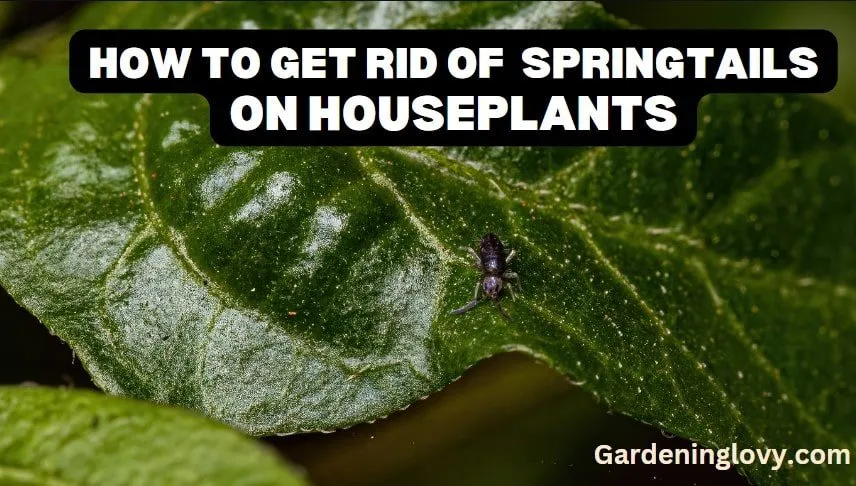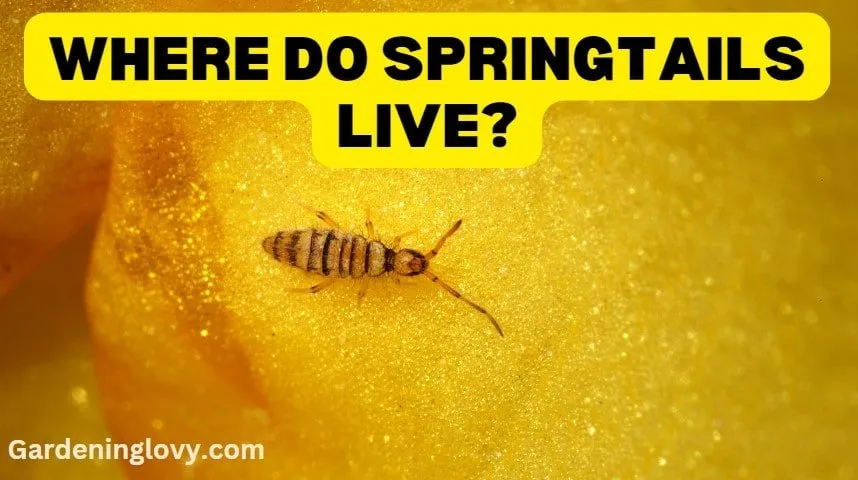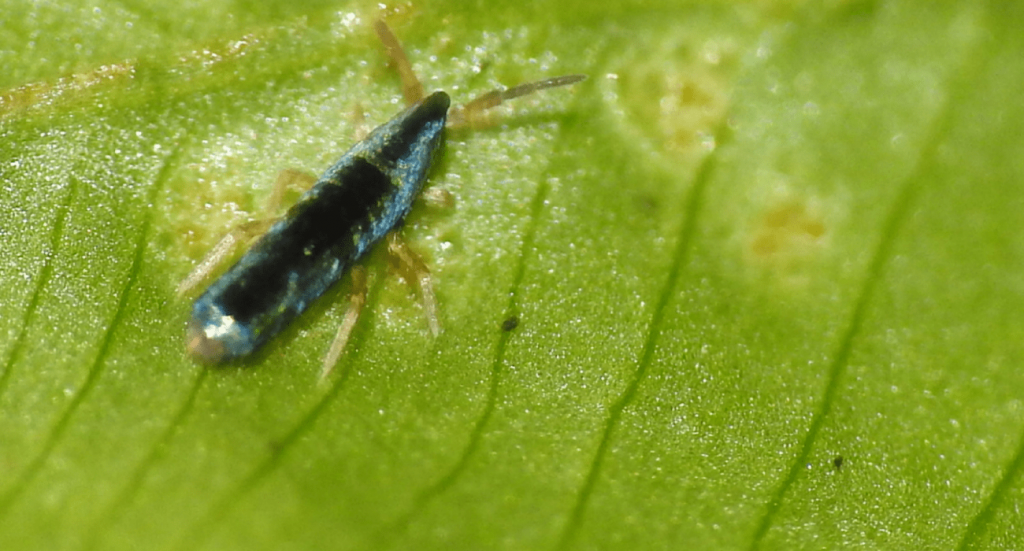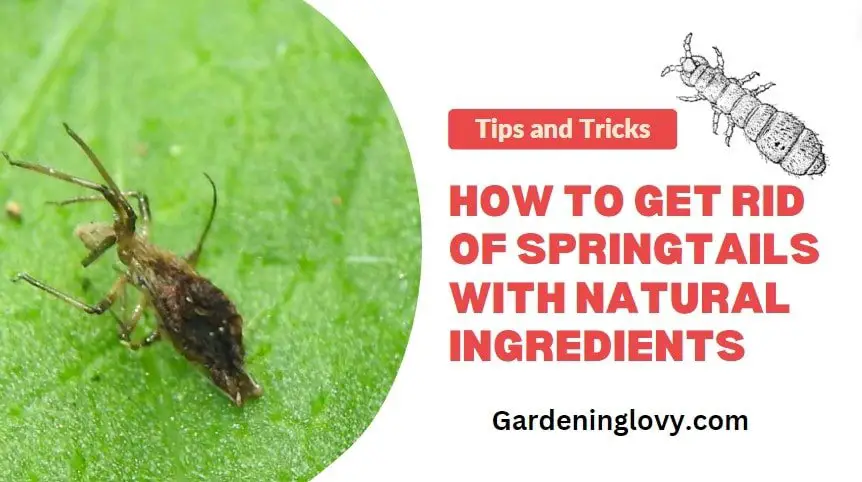Quick Help! How To Identify And Get Rid Of Springtail Bugs Without Any Toxic Sprays. Are you terrified of Springtails? and want to get rid of them permanently in an organic way? Then you are so lucky, you are in the correct place.
To get rid of Springtail’s bugs, first, check the leaking areas in your house and if there is the presence of mold or mildew, immediately clean the drainpipe and let it dry thoroughly.
Similarly, if you spot tiny jumping bugs in the bathroom, carefully inspect them under the sink and nearby for leaking pipes.
Today we will talk on the same topic in detail, and trust me you are going to get 100% correct springtail solutions along with the below points.
First, let’s talk about all the things associated with these horrific creatures.
What Is Springtail?
They are tiny white jumping bugs in soil that are often referred to as springtail fleas and are generally 0.25 to 6mm in size.
These white bugs that jump like fleas got this unique name owing to this tendency to jump when disturbed. Springtails are the bugs that look like fleas to the naked eye, they can still be differentiated from the fleas because of the antennae they have. And the indication bugs that look like fleas but don’t jump.
Read Also, How to Control Thrips In a Natural Way Without Toxic Sprays
The springtails in water absorb the liquid through their body surface as they consistently need moisture to prevent them from drying out.
When the land becomes too saturated with water they come out on the surface in very large numbers. And the same can be said when the land becomes too dry to survive.
What Do Springtails Eat?
Springtails thrive on mold and fungi and even replenish nutrients back into the soil by feeding outside on decomposing vegetation, bacteria, insect feces, pollen, etc.
But you will also notice springtails in houseplants, springtails in pools, and even springtails in bed.
It is so because they go inside underneath the doors and through small cracks and crevices found in exterior walls looking for moisture when the outside weather becomes too dry.
how to get rid of springtails in houseplants?

If you want to get rid of springtails in houseplants follow below steps.
- If you don’t want springtails to develop, let the dirt dry out between waterings.
- To catch male springtails, put yellow sticky traps next to plants.
- To keep water from building up, use dirt that drains well to improve drainage.
- Don’t give plants too much fertilizer, because the extra nutrients can bring in springtails.
- You might want to repot the plants with new dirt to get rid of any springtail eggs or larvae.
Where Do Springtails Live?

As discussed earlier, these tiny jumping bugs survive on moisture so are mostly found in the layer between soil and plant debris, but may also be found in any other place that has high moisture content.
So now how to find a springtail nest?
Their nesting place is commonly woodpiles, flowerbeds, paving stones, and landscape timbers. Springtail bugs are active throughout the year.
While some of them as red springtails look like mites, some adapt to different climates and can even be seen jumping on snow-clad areas where they are often known as snow fleas.
Do Springtail Bugs Bite?
No, don’t worry. If you spot springtails on humans or even pets, they do not bite or sting them. There is no reason to be afraid of springtail bite. But are springtails bad?
Well, even though do not bite or carry disease, since they spread rapidly, finding thousands of jumping springtails in the house can be very distressing, especially during spring and summer. That’s why springtails are also called spring bugs.
But you might have noticed the sign isopods and springtails for sale. Isopods are arthropods similar to springtails. These isopods and springtails clear out decaying vegetation and mold, decompose animal matter, and cultivate good fungi in the gardens.
So, springtails and isopods can be very useful if they are utilized in the gardening area within a controlled environment. Interestingly, some people buy springtails and culture them in springtails terrarium because of these benefits.
So the next time you notice springtails for sale, you will know they can be helpful too. You can search for “springtails and isopods for sale near me” online to get more first-hand knowledge from the sellers.
How To Identify Springtail Damage-Signs Of Infection

The adult springtails survive in places with high levels of humidity and moisture. So they are commonly found in decaying vegetation, compost piles, and forest areas. Sometimes they even much on plant roots but there is minimal damage.
Do springtail bugs bite? No, there is no danger of bug bites whatsoever, but you have to be careful as when they start to reproduce rapidly in a moist environment, then they do create a ruckus.
If the springtail bug infestation is not stopped at the earliest stage, then they will spread anywhere looking for moisture even inside the home kitchens, bathrooms, and basements.
How To Get Rid Of Springtail Bugs In The House

The springtail infestation in the house feeds on mildew. So if you do find a springtail in the sink, start inspecting it under the sink as well. If your drainpipe has been leaking and there is the presence of mold or mildew, immediately clean the drainpipe and let it dry thoroughly.
Similarly, if you spot them in the bathroom, carefully inspect under the sink and nearby for leaking pipes.
If there is any leakage or any gaps in the wall tiles, it can become the breeding ground. For the basements, it is advisable to get some waterproofing done.
If have not done that already, buy some waterproofing compound from the nearest home store to check the dampness and get rid of the springtail.
How Did I Get Springtail?
Where Does Springtail Come From? – As springtails bugs thrive on moisture, dampness, and humidity, you would often find them indoors or in your garden during dry weather or after a heavy spell of rain.
They might get mistaken for fleas so it is important to identify them properly and take measures accordingly.
They can survive in most climates but their occurrence in humid weather increases, and since they are attracted to light, you might find that this could be a reason they have entered your home.
What Does Springtail Look Like?
Springtails can be identified as small, soft-bodied, and wingless pests that have six legs and eight eyes. They are hard to spot as they are usually between 0.25 to 6mm in size.

If you look at pictures of springtails, you will see their most peculiar feature – a forked tail (furcula) just below the abdomen. With the help of these tails, they release springtail larvae to bounce off against the ground and jump to move around.
Usually cylindrical or spherical, they might appear to be tiny gray bugs on the window sill but on a closer look at the springtail images, you will find that are found in multiple colors like black springtails, silver springtails, red springtails, and yellow/orange springtails to name a few.
How Many Types Of Springtails Are?
There are more than 6,500 species of springtails (Scientific name – Collembola) found all over the world. There are still instances of new species being discovered like the deep cave springtails. But they can be broadly classified into three family groups:
- Symphypleona – From the springtail’s pictures, you can observe that these are extremely round insects, more spherical, and commonly have longer antennae than the other two groups.
- Entomobryomorpha–This family group consists of the slimmest springtails. They are found to be with longer bodies with short legs and antennae, or else, with long legs and antennae with a fully developed tail.
- Poduromorpha – This group’s springtail size is more on the plump side, with short legs. However, they are more oval compared to the Symphypleona.
Reproduction & Life Cycle Of Springtails
- Springtails reproduce at an exponential rate and transform into adults from eggs in a matter of a few weeks. Female springtails pick up the sperm sacs distributed by the males, and fertilization of eggs (individually or in groups) begins as soon as they are laid on or inside the ground. A single female is known to lay as many as 400 eggs during its springtail life cycle.
- Eggs – The average hatching duration of springtail eggs is of hardly ten days, with an even shorter duration in a warmer climate. The young white springtails look similar to adults but do not have developed reproductive organs yet. It takes them five to eight growth stages with molting during each one, before they are fully matured.
- Adults – Springtails transform into fully mature adults usually in six weeks. However, they keep on growing through the stages of molting as many as fifty times during their lifetime though not growing in size. While rapidly reproducing, they have a life span of close to one year.
How To Get Rid Of Springtail Naturally- Tips?
With proper insulation and roof protection in place, you can get rid of accumulated heat and rainwater. By avoiding dampness inside your home, you will ensure that this small white jumping bug is not attracted to your area. Let’s talk about some effective ways and tips to get rid of springtails.
Are Springtails Harmful?
Yes, when the springtails bug grows out of control. You would have often seen homeowners remove a cluster of springtails from a patio or sink and believe they have taken care of the problem, but very soon a new group of springtails spring up in the same place or nearby in a matter of few days.
Then what are you supposed to do and how to get rid of springtails? Well, you have to locate the nesting area of springtails which is usually hidden and remains unnoticed.
Springtail infestation spreads rapidly from this nesting area again. That is why it is important to remove their nesting area. You can try these measures for an effective springtail treatment:
Improve Home Ventilation
As springtails thrive in a moist environment, the first and most important thing to consider is minimizing moisture areas inside your home by enabling better air circulation.
Now for the next step, you need to search for any nesting areas near your place. These nesting grounds will be somewhere that is dark and damp, and will not be very far from your place as they do not move around much after settling in a habitat.
Such areas could be around pool decks, below logs, woodpiles or inside flower pots, kitchen/bathroom sinks, wood decks, etc.
If you do not want to use chemicals to get rid of this white jumping bug, then the best available options are using a mix of soap and water or using vinegar to spray on the nesting grounds regularly.
What spray kills springtails? If you want to buy springtail spray, you can get it Here.
Due to the high acidic content, it serves as an effective remedy and we will discuss them later too. You can also use cider vinegar which is anti-fungal and will also take care of the issue of mold in those areas.
How To Get Rid Of Springtails In The Soil
In areas where the soil has a high moisture content, it serves as a suitable habitat for the nesting ground of tiny white bugs in soil springtails.
Are Springtails Harmful To Plants?
Yes, so regular inspections should be done of tiny silver bugs in houseplant soil and the garden to make sure there is no cluster of these pests.
Keep the drain areas and damp surroundings of these plants clean as much as you can. To keep them off your home, try to avoid these plants and other organic matter anywhere near the floor of your home.
If there are any signs of tiny white bugs in the soil, let the soil dry out completely first and then only bring it inside the home again.
Tips for getting rid of springtails in soil
In the garden area outside your home, springtail removal in soil by limiting the compost and organic materials until the springtail bugs have disappeared. Also, you might have to let the soil dry out completely before you start watering the garden again.
How to Get Rid Of Springtails In Bathrooms
If there are springtail bugs in the bed or the bedroom area, it is possible that they may have formed a nesting ground in the adjoining bathroom where there is plenty of moisture. They look like a small silver bug in bed.
- You will have to keep a constant check on any signs of infestation under the sink, in the shower, or tub area.
- Also, there could be gaps or cracks in the wall tiles which may cause mold buildup and encourage the springtail insect to settle down.
- Fix any leaks in the pipes and drains, repair the cracks, and use soap solution or bleach to properly clean the bathroom to get rid of these pests. Once you have located the nest.
Remember that spraying chemicals will only solve the problem temporarily if you don’t maintain the cleanliness and dryness of such areas. At the first sign of humidity, these tiny yellow jumping bugs might be back.
How to get rid of springtails in bed
Let us find below quick ways to control springtails in bed
- To get rid of springtails and their eggs from your mattress and sheets, vacuum them very well.
- If there are still springtails on the fabric, wash it in hot water to kill them.
- To keep springtails out of your bedroom, make sure it has good airflow and less wetness.
- Mattress covers will keep springtails from getting into or out of the mattress.
- You might want to use a dehumidifier to lower the dampness, which will make the area less appealing to springtails.
How to get rid of springtails outside
Here are easy ways to control springtails outside.
- Fixing the drainage in outdoor places will keep water from building up, which is what springtails want.
- Cut back plants and get rid of trash that springtails could hide in.
- Nematodes or diatomaceous earth are natural ways to get rid of springtails outside.
- Lessen the lights outside because it can bring in springtails.
- To help keep springtail numbers in check, bring in natural predators like ground beetles or spiders.
How to get rid of springtails naturally in the kitchen
Let us vanish springtails naturally in the kitchen, check the below steps.
- To get rid of food sources and keep springtails away, keep cooking surfaces clean and dry.
- Keep food in containers that don’t let air in so that springtails can’t get to it.
- Fix any kitchen leaks or moisture problems to keep springtails from coming in.
- A natural wash made of vinegar and water can be used to keep springtails off of surfaces.
- In cracks and gaps where springtails might hide, sprinkle food-grade diatomaceous earth.
how to get rid of springtails on the window sill
Here are easy ways to kill springtail window sill.
- Thoroughly clean the window sills to get rid of any dirt or organic matter that springtails might be interested in.
- Fill in any holes or cracks around windows to keep springtails out.
- To keep springtails off the window sill, use a natural spray that repels them, like peppermint oil mixed with water.
- Put screens on your windows to keep springtails out of your home.
- Sticky traps or walls should be put around the window sill to catch springtails and keep them from coming inside.
Other quick ways To Kill Springtail In An Organically
If you are thinking of how to kill springtails, then the most effective way is to use vinegar as its high acidic content burns and kills them instantly.
- Vinegar spray is a proven way of getting rid of springtails inside the home. However, it is a little expensive method and if there is an uncontrolled infestation, you might have to use it several times to get the desired result.
- If you are hoping for a comparatively less expensive method then you can try washing the affected area with detergent and water. This solution works like vinegar and burns the white springtail.
- Many homeowners opt for this method as it is reasonable and can be used several times to clear off the infestation. Diatomaceous earth (DE) is another natural way to remove groups of springtails.
- Besides this, neem and eucalyptus oil can also be equally effective. But particularly, when clove oil is mixed with another essential oil, it serves as a better option than the other oil concentrations.
Who Can Eat Springtails?
Another natural way to get rid of springtails is to make use of certain springtail predators like beetles, wasps, and ants. They can be very useful in keeping a check on this pest infestation.
- There are often cases when springtail insects appear to be quite resistant to soap solution and vinegar. At such time, you will have to opt for stringent remedies like using bleach or insecticides which are a stronger and quicker way to get rid of this infestation.
- Bleach has corrosive properties and is capable of eliminating groups of springtails. But as you may be aware, bleach has a strong smell, and using it inside the home might cause you some discomfort.
- If you do not want to use bleach, then the only option available is to move to insecticides. They can be easily bought from departmental or home stores and come as liquid concentrates and spray mixes.
- The insecticides poison entire clusters of springtails and serve as an effective springtail killer. Since they have lethal ingredients, we recommend extreme caution while applying them or it might be better to call a professional exterminator and let them handle the problem in the best way possible.
Find below the most requested Frequently asked questions on how to get rid of springtails.
Q: Are springtails in soil good or bad?
Springtails are generally bad for the plants. They will eat soil and plant roots. Be that as it may, they are rarely harmful to humans. They don’t nibble or sting at all.
Q: What are springtails attracted to?
Springtails are pulled into inordinate dampness and natural material. They live in soil or under rotting wood or bark, flourishing in territories with leaf litter, manure and natural mulches. Springtails feed on molds, parasites, green growth and rotting plant material.
Q: How do you kill springtails?
What kills springtail bugs- Shower vinegar straightforwardly on the springtails, and take a cloth, and spread the vinegar around affected regions.
Q: Do springtails jump on humans?
Little white crawling bug:- Springtails do not jump on people and don’t bite too.
Q: How big are springtails
Springtails can be measured as 1-2 mm long with six legs and a head, thorax, and abdomen.
Q: what eats springtails
Springtails can be eaten by a few deadly creatures like dart frogs, creepy spiders, newts and salamanders.
Conclusion
As we have discussed all the tips to cure jumping black bug springtails, in this blog. Let’s summarise points quickly.
- If you are trying to either take care of early springtail spread or eliminate an entire nest of infestation, you will need to take proper measures as discussed.
- But remember to maintain a clean environment in your home and garden to ensure they don’t get encouraged to come back.
- Also, keep your family and pets safe, and take precautions while using any soap solution or chemicals. It is always better to stop springtails infestation before they take over your home and life.
Find more useful, gardening articles below.
- Hanging Air Plants: How To Care + Maintain
- How To Plant & Grow Mustard Seeds – Exclusive Caring Tips
- How to Control Thrips In a Natural Way Without Toxic Sprays
- How To Care Outdoor Hanging Plants – A-Z Doable Tips

My name is Olivia, and I live in the United States and love having plants in my garden. Lots of plants are there on my balcony, indoor and outdoor garden also. Here I am trying to share useful gardening tips, how to grow and care for various plants, etc.

If someone wishes expert view concerning blogging
then I advise him/her to pay a visit this website, Keep up the fastidious work.
Also, visit my web site Royal CBD
Thanks, keep visiting my site for more informative tips & tricks